Step-by-step instructions for planting beets in open ground in spring and further caring for them
Beetroot is a popular vegetable in our country. It is used to prepare vinaigrette, borscht and salads, baked, boiled and pickled. It is quite possible to grow a large harvest of beets in your garden. In this article we will talk about the nuances of caring for the crop and choosing a variety, consider advanced growing technologies and features of storing beets at home.
After what crops can beets be planted?
Every year, beets should be planted in open ground in spring in different areas.. You can return to your previous landing site after no less than four years. This is due to reasons such as:
- soil depletion;
- breeding of pests;
- development of diseases.
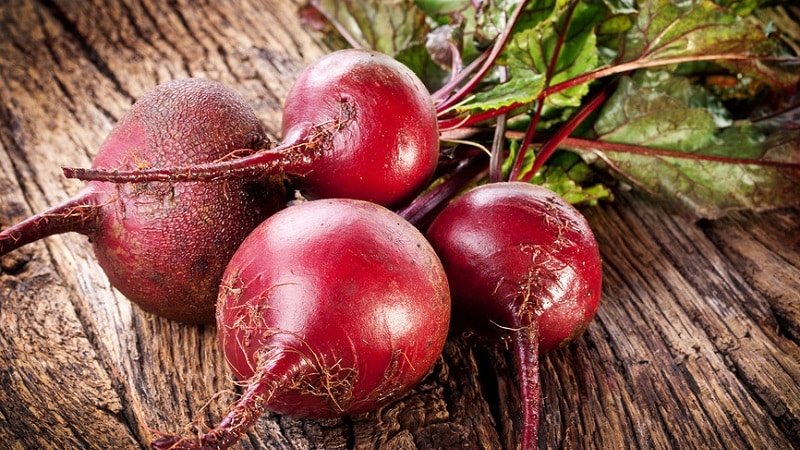
Beets like to grow after nightshades: potatoes, tomatoes, eggplants. It is also useful to plant it after plants rich in essential oils: garlic and onions.
It is good to plant beets after cucumbers, squash, and zucchini.. The roots of these plants grow on the surface, so the necessary nutrients for beet growth remain in the soil.
What to plant after beets and what to combine planting with
When observing crop rotation, it is important to remember that you should not plant crops of the same family in one place. After harvesting, plan to plant garlic, eggplants, cucumbers, pumpkin or carrots in this place next year.
To save space in your garden, plant together. Plant parsley, onions, spinach, lettuce, and dill between the rows of beets.
Variety selection
Table beets are grown in vegetable gardens, which is used to prepare borscht, vinaigrette, and salads.
 Varieties differ in terms of ripening:
Varieties differ in terms of ripening:
- Early ripening - from 50 to 80 days.
- Mid-season varieties - from 80 to 100 days.
- Late ripening - longer than three months (such root vegetables are stored longer and have a rich taste).
When choosing a variety, it is necessary to take into account that the sizes and shapes of root crops differ from each other.:
- spherical;
- cylindrical;
- elongated;
- flattened.
Advice. Choose varieties bred in your area for planting in your garden.
When to plant a vegetable
Planting seeds on time is the key to a bountiful harvest.. Beets do not like the cold; they are planted when the earth is already warm.
Calendar dates
Sowing beets in open ground in spring begins when the daytime air temperature reaches 16°C. The vegetable is planted after planting the carrots; the time for sowing the seeds is before May 15. In warmer regions, planting begins at the end of April. If spring is delayed, planting dates are postponed a week later. The main thing is that the weather is warm.
Planting according to the lunar calendar
The lunar calendar will help you calculate the correct days when to plant beets in the spring and carry out timely planting.. It has been used since ancient times, calculating the time of planting crops depending on the phase of the moon. Our ancestors noticed that when it grows, the above-ground part of the plant actively develops, and when it decreases, the root system grows. The calendar is calculated annually.
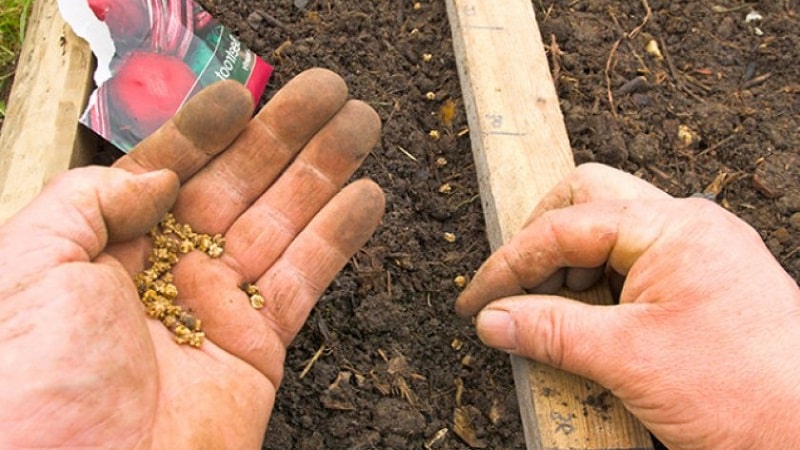
Growing and care
Planting and caring for crops in open ground in spring requires the following measures::
- Seed preparation. For germination, the seed is soaked for three days in a water solution, adding 1 tsp. soda per 0.5 l.
- Landing in the ground.Before sowing the seeds, the prepared wells are watered with a hot 1% solution of potassium permanganate.
- Seeds are sown in holes at a distance of 3-5 cm from each other.
- During planting, nitrogen fertilizers are applied: 1 tbsp. l. ammonium nitrate per 1 m of bed.
- The soil is loosened throughout the entire period of crop growth.
- When the seedlings grow to 7 cm, they are thinned out, leaving 10 cm between plants.
- The soil between the rows is mulched with straw and mown grass.
It will be interesting:
Top 12 best beet varieties: review and selection tips
Soil preparation
Preparing the soil for planting begins in the fall or early spring. Choose illuminated places where there is no groundwater.
The remaining vegetation is removed from the garden and the soil is dug up. If the soil is too acidic, add lime by spreading it in a thin layer before digging.
When preparing to grow beets, pay attention to the condition of the soil. Beets do not like clay soils. Acceptable soil is loamy, sandy loam, black soil.
Measures to improve the soil in the garden:
- If the site has acidic soil, wild sorrel, rapeseed, and horsetail grow, lime should be added.
- Clay soils require the addition of sand.
Seed preparation and planting procedure
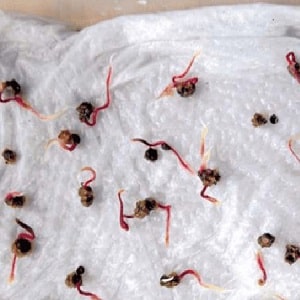 Seed preparation will help avoid diseases and grow crops without loss. Let's consider what activities should be carried out:
Seed preparation will help avoid diseases and grow crops without loss. Let's consider what activities should be carried out:
- Hardening. The seeds are placed in the freezer for 30 minutes.
- Disinfection. The seeds are poured with a light pink solution of potassium permanganate and kept for two hours. Then the water is drained and the seed is dried.
- Soak. The seed is placed in a deep plate, filled with water so that it covers the seeds, and placed in a dark place for three days.
The autumn harvest depends on the correct planting of beets in the spring.
Planted in two ways:
- Seeds. Make holes 3 cm deep in the ground and fill them with water. When it is absorbed, place the seeds at a distance of 3-5 cm from each other. Cover with soil, compacting the top layer of soil.
- Seedlings. Seeds are sown in a greenhouse, planted four per hole. When four leaves grow, they are transplanted into the ground. Before planting, seedlings are hardened off by regularly ventilating the greenhouse.
Advice. When thinning beets, the ones that are pulled out can be used as planting material. She is accepted and grows.
Thinning of seedlings
When planted densely, plants grow poorly, the stems weaken and become elongated.
To form a bed, two thinnings are carried out:
- When the second leaf appears. The seedlings are thinned out, removing excess ones. The distance between plants is maintained at 7 cm.
- In three weeks. Leave a distance between plants of 15-20 cm.
Important! Before thinning, the bed must be watered so as not to damage the roots of the plants when pulled out.
Care
Care includes fertilizing, watering, loosening and mulching.
Feed twice a season:
- When the seedlings grow four leaves. Seedlings are fertilized after rooting. Urea is added at the rate of 10 g per 1 sq. m.
- A month later. During this period, plants need potassium-phosphorus fertilizers. 1 tbsp. l. superphosphate and potassium chloride are diluted in a bucket of water. Fertilizers are designed for 1 square. m. landing.
Attention! Fertilizers must be applied after watering.
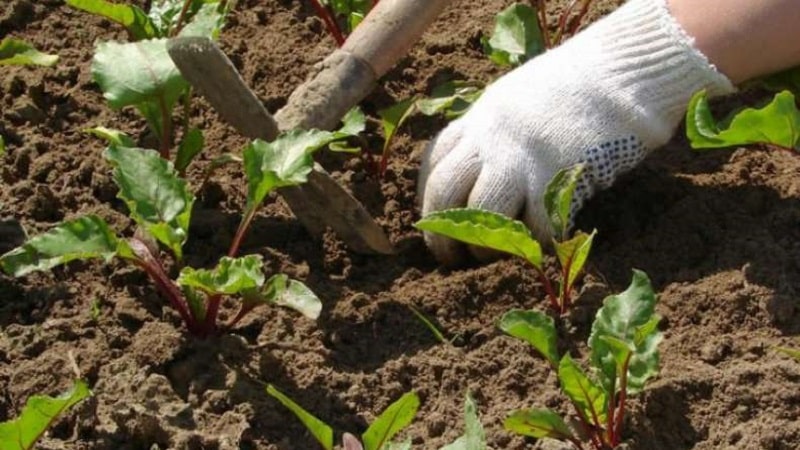
What to do about the following problems:
- The core of the root crop rots – there is not enough boron or copper.In this case, foliar fertilizing is done with boric acid (1 tablespoon per 1 liter of warm water).
- Yellow spots appeared on the tops – potassium deficiency. Deoxidize the soil by adding lime milk (dilute a glass of lime in 10 liters of water, add 1 tablespoon of potassium chloride). The solution is enough for 10 linear meters. m beds.
- Beet tops turn red for a lack of sodium - sprinkle the garden bed with ash or water it with salt water (a glass of salt per bucket of water).
Beets love moisture, so they need careful watering.
Watering rules:
- shower the plants from above;
- pour thoroughly so that the water penetrates deep into the roots;
- after watering, loosen the soil;
- do not allow the soil to dry out.
To enrich plants with oxygen, the soil should be loosened after each watering.. In order not to damage the root crops, loosening is carried out between the rows.
Mulching will help retain moisture in the soil.. To do this, use straw and hay, laying mulch in a 3 cm layer in rows.
Pests and diseases
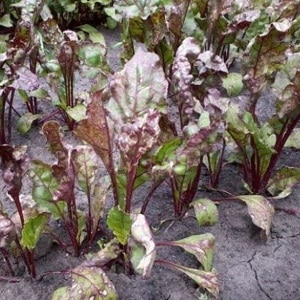 There are more than 30 pests that most often attack young seedlings. The most common of them:
There are more than 30 pests that most often attack young seedlings. The most common of them:
- Beet aphid spreads on leaves.
- Root aphid: affected plants turn yellow, wither, the roots are covered with a white coating, the plants are easily pulled out.
- Beet flea beetle affects young shoots. If you don't react in time, it can destroy the entire plantation.
- Weevil overwinters in the soil and attacks the first shoots.
- Mining fly lays eggs in early spring. The hatched larvae penetrate deep into the stem, feeding on the tissue. Such plants die quickly.
- Beet nematode - a small thread-like worm that penetrates the root and disrupts its structure. The roots branch excessively and the vegetables lose weight.
Beets are susceptible to the following diseases:
- Corneater – microorganisms that damage beet seedlings. The shoot stem becomes constricted and the root dies.
- Cercospora – a fungus that multiplies in the tissues of leaves and grows into a mycelium. Over time, many spots form on the leaves, the plant withers and disappears.
- Downy mildew - a fungal disease that attacks leaves. The color changes, the leaves grow poorly and die over time. Root crops affected by the disease quickly disappear.
- Fomoz appears due to boron deficiency. In young plants, the disease affects the roots, they rot and dry out. On adult plants, Phoma appears as light brown spots. Such root vegetables rot quickly.
- Kagatny rot - a type of fungal disease. Affected fruits are dark in color and cannot be stored.
Read also:
Harvesting and storage
Harvesting begins in late autumn, before the first frosts appear.. Beets are stored in cellars, piled high. If the harvest is small, you can store the fruits on a glassed-in loggia, placing the root crops in a basin and covering them with oilcloth on top so that they do not dry out.
Advice. If you store the crop on a loggia, when harvesting you need to leave a little soil on the roots.
Features of planting and care depending on the region
The timing of planting and methods of caring for beets depend on the region where the vegetable is grown.
Features of crop care in warm regions:
- Planting begins at the end of April, the harvest is harvested in August.
- In hot weather, water twice a week.
- To preserve moisture, mulch the ground.
- In black soil conditions, fertilizers are applied twice per season.
In cold regions:
- The vegetable is planted in May and harvested in September-October.
- Watering is carried out if necessary.
- The soil does not need to be mulched.
- Due to the cold, wet weather, fungal diseases are prevented. Plants are sprayed with preparations containing copper.
General growing rules
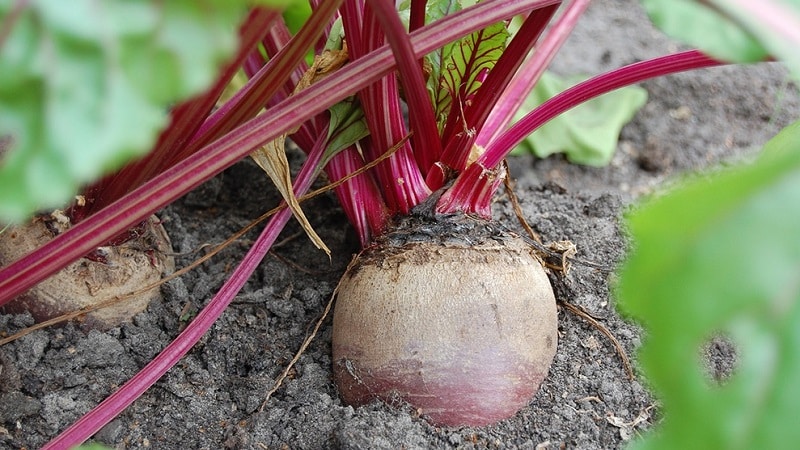
It is not difficult to grow beets and get a good harvest. We present to you a few simple care rules:
- Prepare the beds in the fall. Dig up and add 1 sq. m: 10 kg of rotted manure, 30 g of potassium chloride and superphosphate.
- Thin out plantings.
- Keep the beds clean.
- Do not allow the soil to dry out.
- Timely combat pests and diseases.
Conclusion
It is not difficult to get a rich harvest by carefully following all the rules for caring for beets. Spring planting gives good results and has a number of advantages. The harvest ripens later and is stored longer.
When starting to plant, you need to remember that beets do not like acidic soils. Crop rotation will help get rid of diseases. The vegetable is moisture-loving, so timely watering is important. In hot regions, beets are watered twice a week. To prevent plants from crowding and interfering with each other, thinning is carried out.